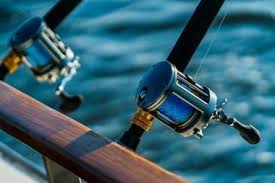
FISH FINDERS:
One of the great mysteries of boating is wondering what lurks beneath the waves. More specifically, how deep is the water, where are the submerged rocks, and where are the fish?
Fundamentals
A fish-finder is an electronic device, consisting of a display and a transducer that uses sound waves (Sound Navigation And Ranging, or sonar) to “see” things in the water under your boat.
The sonar unit sends high-frequency sound waves through the water and waits for them to bounce off of underwater objects and return. By processing the outgoing and incoming sound waves, a fish-finder can determine, among other things, water depth, submerged structure, and where those sneaky fish are hiding.
 Displays
Displays
The fish-finder display screen shows you what the sonar’s seeing under your boat. The display’s graphics can be monochromatic (shades of gray) or color, depending on the unit.
Some fish-finder display screens work well in direct sunlight, whereas other displays tend to fade/wash out in the sunshine. This is important, because if you can’t make out what’s on the screen on a sunny day, the fish-finder might as well be an electric paperweight.
Display resolution, measured in pixels, determines the clarity of the image appearing on the display screen. More pixels means a sharper representation of what’s in the water below your boat.
Transducers
The transducer is responsible for transmitting and receiving the sonar’s sound waves. These sound waves radiate from the transducer in a cone-shaped formation called a beam. Beam width refers to the angle of the sound waves as they’re sent through the water.
A transducer with a wide beam width shows a larger area of the bottom in shallow water; a narrow beam width works well in deeper water.
One of the keys to good transducer performance is to mount the transducer in an area free of turbulent/bubbly water—off to one side of the transom, if possible. The transducer should be installed so it is perpendicular to the lake bottom, for maximum sound wave efficiency.
Bells & Whistles
Temperature sensors tell you what the surface water temperature is—information that may not be relevant to water temps in deeper water.
A paddlewheel transducer provides fairly accurate boat speed, a very important piece of data when you’re trolling. In addition, a paddlewheel transducer can tell you how far the boat’ traveled in a given time frame.
Bottom hardness is displayed as a horizontal line across the screen. With experience, you’ll be able to determine if the bottom is solid or muddy.
Fish icons identify potential fishy targets as sweet little fish shapes on the display screen. These video game-like characters get annoying real quick—we prefer our quarry displayed as fish arches—a much more accurate way to differentiate between weeds that might look like fish, and real fish.
Alarms that sound off when you’re in shallow water can prevent you from running aground (hitting bottom)—easy to do when you’re concentrating on catching fish. Be aware that since the transducer is at the back of your boat, the front of the boat is already in shallow water by the time the depth alarm sounds—so pay attention.
Keep in mind that although an electronic fish finders can show you where the fish are, it’s still up to you to catch them.
 We hope you find this guide helpful. For more information please contact us at Coast Road Motors. Our team will be happy to answer your questions and help you.
We hope you find this guide helpful. For more information please contact us at Coast Road Motors. Our team will be happy to answer your questions and help you.
We’re located at 4133 Yorke Hwy ARDROSSAN SA 5571
Phone us on (08) 8837 3202
Researched and formatted by a staff member for our requirements.


